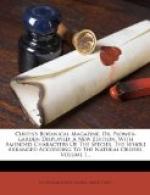[139]
ALSTROEMERIA PELEGRINA. SPOTTED-FLOWER’D ALSTROEMERIA.
Class and Order.
HEXANDRIA MONOGYNIA.
Generic Character.
Corolla 6-petala, supera, irregularis. Stamina declinata.
Specific Character and Synonyms.
ALSTROEMERIA Pelegrina caule erecto, corollis
campanulatis rectis,
foliis lineari-lanceolatis
sessilibus. Linn. Syst. Veg. p. 338.
ed. Murr.
Amoen. Acad. 6. p. 247. cum icone.
HEMEROCALLIS floribus purpurascentibus maculatis vulgo
Pelegrina.
Feuill.
Peruv. 2. p. 711. t. 5.
[Illustration: No 139]
Father FEUILLEE[3] figures and describes three species of Alstroemeria, viz. Pelegrina, Ligtu, and Salsilla, common names by which they are severally distinguished in Peru: the present species, which is much valued by the natives on account of its beauty, he informs us is found wild on a mountain to the north of, and a mile distant from Lima.
From Peru, as might be expected, the present plant found its way into Spain, from whence by the means of his beloved friend ALSTROEMER, LINNAEUS first received seeds of it; the value he set on the acquisition is evident from the great care he took of the seedling plants, preserving them through the winter in his bed-chamber.
According to Mr. AITON, this species was introduced to the Royal Garden at Kew, by Messrs. KENNEDY and LEE, as long ago as the year 1753.
Being a mountainous plant, it is found to be much more hardy than the Ligtu already figured, and is generally treated as a green-house plant; it is found, however, to flower and ripen its seeds better under the glass of a hot-bed frame, where air is freely admitted.
It flowers from June to October, and, though a perennial, is generally raised from seeds, yet may sometimes be increased by parting its roots, which somewhat resemble those of the asparagus: the seeds should be sown in the spring, in a pot of light earth, on a gentle hot-bed, either of dung or tan.
[140]
LUPINUS LUTEUS. YELLOW LUPINE.
Class and Order.
DIADELPHIA DECANDRIA.
Generic Character.
Calyx 2-labiatus. Antherae 5 oblongae,
5 subrotundae. Legumen
coriaceum.
Specific Character and Synonyms.
LUPINUS luteus calycibus verticillatis appendiculatis:
labio superiore
bipartito; inferiore
tridentato. Linn. Syst. Vegetab. ed. 14.
Murr. p. 656.
LUPINUS sylvestris, flore luteo. Bauh. Pin. 348.
The Yellow Lupine. Park. Parad. p. 336.
[Illustration: No 140]
The present, with many other species of Lupine, is very generally cultivated in flower gardens, for the sake of variety, being usually sown in the spring with other annuals; where the flower-borders are spacious, they may with propriety be admitted, but as they take up much room, and as their blossoms are of short duration, they are not so desirable as many other plants.




